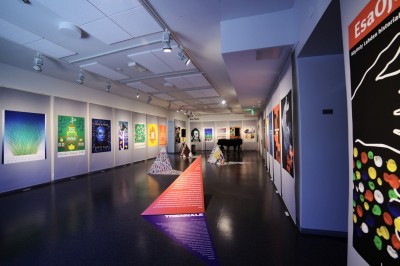
View of the exhibition. Photo: Toni Kesti / Lahti City Museum
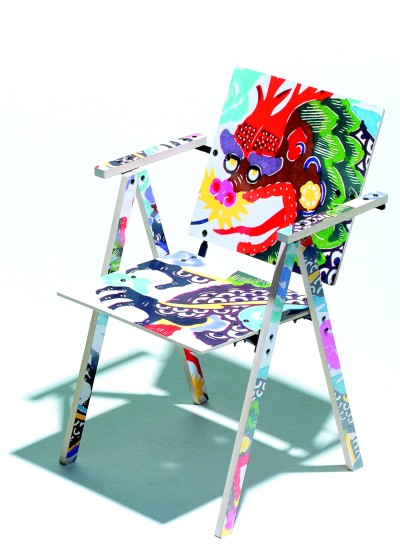
Dragon chair by Tapani Aartomaa and Yrjö Kukkapuro. Yrjö Kukkapuro’s archive
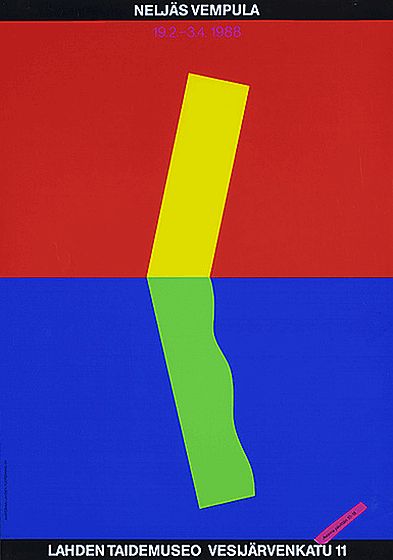
Tapani Aartomaa. Neljäs Vempula -näyttelyjuliste. Tapani Aartomaa’s archive
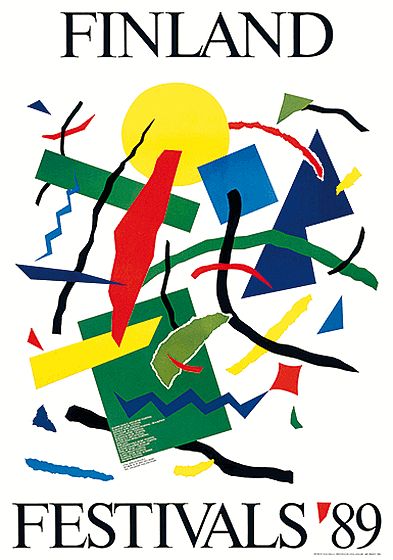
Esa Ojala: Finland Festivals '89 -juliste. Esa Ojala’s archive
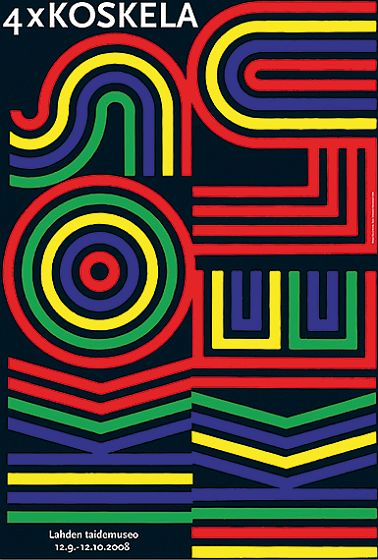
Esa Ojala: 4 x Koskela. Esa Ojala’s archive
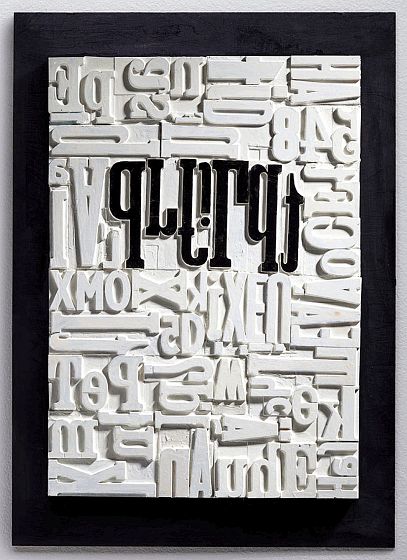
Kyösti Varis: Puukirjainreliefi. Kyösti Varis’s archive
Exhibition in Lahti Historical Museum 25.4.2014 - 1.3.2015
The Triennial Plus exhibition brings together some of the biggest names in graphic design! The exhibition forming part of the Lahti International Poster Triennial, covers a wide range of art pieces, including posters by Tapani Aartomaa and Esa Ojala, chairs designed by Tapani Aartomaa and Yrjö Kukkapuro, wooden letters by Kyösti Varis, and works designed by members of the international jury of the Lahti International Poster Triennial.
Tapani Aartomaa (1934-2009)
Tapani Aartomaa was born in Karuna in 1934 and died in Helsinki in 2009. He worked at various advertising agencies from 1957 until 1963 when he founded Studio Aartomaa. He was an instructor at the Lahti Institute of Design between 1972 and 1986 and worked as an assistant professor and then professor at the University of Industrial Art Helsinki from 1986 to 1998. Over the years, his work was recognised with numerous awards and prizes, including the 2001 Finnish Graphic Designer of the Year. In 1975, Aartomaa was one of the founding members of the Lahti Poster Biennial, which he chaired until 2005. He sat on the juries of several national and international competitions. He also lectured and held exhibitions and workshops abroad.
Yrjö Kukkapuro - Tapani Aartomaa: Tattooed Chairs
Tapani Aartomaa and Yrjö Kukkapuro's friendship goes back to the late 1950s when they met as students at the Institute of Industrial Arts in Helsinki. Both men later worked as instructors at the Institute, and in the 1980s, they both held positions in Finnish industrial design organisations. For Aartomaa and Kukkapuro, designing chairs was a welcome distraction from their everyday work.
In 1990, Tapani Aartomaa and Yrjö Kukkapuro had the idea of making a chair for each member of the Lahti poster biennale jury. A couple of years later, a chair poster was needed and the decision was taken to produce one based on a black and white drawing by Yrjö Kukkapuro. Many chairs and posters were made, mainly for exhibitions in different countries. The latest collaboration between Yrjö Kukkapuro and Tapani Aartomaa was for Swiss art dealer and gallerist Bruno Bischofberger's private museum in 2010.
Poster and stamp art by Tapani Aartomaa
The earliest posters on display date from Aartomaa's student days in the late 1950s. The 'Finnish Design' poster (1959), designed for the Finlandia poster competition, is the most 'modern' of these early works. His next landmark design was the photo-based 'Stop!' poster, published in 1971. The message of this poster is just as relevant today as it was when it was first published. Aartomaa's most productive years as a poster artist were in the 1980s and '90s when he designed posters for the Lahti Art Museum and other galleries and museums. The form language of many of the posters of this era is formalistic, characterised by the use of bright primary colours, and based on typography, with echoes of iconic Bauhaus designs. His 'Vempula' posters fall into this category. The often humorous posters have bold lines and bright colours, with a hint of influence from Polish poster art. The posters for the Franco Balan and Kari Piippo exhibitions are other fine examples of this style. In the 2000s, Aartomaa's expression became increasingly minimalistic. Many of his last works express his views on contemporary social and political issues. His last poster, 'Hommage à Shigeo Fukuda', pays homage to a Japanese colleague. It went on display in Helsinki two days after Aartomaa's death.
'Postage stamps are mini ambassadors of Finland'
A candid newspaper interview with Tapani Aartomaa led to an invitation to join the Finland Post Stamp Art Committee in 1994. Aartomaa thought that the themes of Finnish stamps should cover culture, technology, and education - not just tranquil rural scenery. He was particularly keen to promote Finnish design, arts, and architecture as themes for stamps. Aartomaa started designing stamps himself in 2003. He designed 24 stamps, their first day covers and postmarks, and the art on the rolls of stamps. Aartomaa's stamps focus on people and places that were close to his heart: Sibelius, Hvitträsk, and Gallen-Kallela. The last stamps designed by Aartomaa - the 'Building a Nation' miniature sheet, depicting the 1809 Diet of Porvoo - were issued on 22 January 2009.
Aartomaa's studies, work, teaching
Aartomaa spent the 1950s studying and working for various advertising agencies. He completed the ABC art correspondence course, taught by well-known artists, including Unto Pusa and Olavi Valavuori. While studying at the folk high school, Aartomaa met and became friends with printmaker Erkki Hervo and painter Onni Oja, whose encouragement and artistic guidance are reflected in his works. His early inspirations included the bold and boisterous woodcuts of Erkki Tanttu and Vilho Askola that were familiar to him from newspapers and books. Yrjö Rosola, a sculpture instructor at the Institute of Industrial Arts in Helsinki, introduced Aartomaa to metal casting. In the mornings, he attended Mainosgraafikoiden koulu, a graphic design school for advertising art, where he was taught by the legendary designer Björn Landström, whose advice for young designers to keep up with the latest developments in the world of art stayed with Aartomaa for the rest of his life. Another inspiration were book covers by Martti Mykkänen, which he would admire in the windows of local bookshops.
Aartomaa's working career began as a window dresser at the Fazer factory in Hietalahti in 1956. He worked for advertising agencies until 1963 when he established his own studio. At the advertising agencies, the young designer was tasked with creating advertisements for banks, Valio cheeses, and insurance companies. Today, these early works offer a nostalgic glimpse into everyday life in the 1950s and 60s.
At a 1950s advertising agency, graphic designers wore white coats and created their designs with watercolour and gouache paints and traditional inks. The tools used included compasses, rulers, and prism rulers. Ellipses and circles were drawn using stencil templates. Prism rulers were used for drawing, and rolling rulers were used for creating parallel lines. Font sizes were measured using a typometer. Dr. Ph. Martin's bottled inks and colours were popular with designers because of their brightness and vividness. Later, coloured felt-tip pens were used instead for preparing sketches and originals for printing. In the 1960s, the development of new cameras changed the way advertisements were created and how they looked, as photographs replaced the earlier hand-drawn designs. Designing an advertisement sometimes even required creating a new font because the selection of fonts offered by printers was often limited. The layouts of books, newspapers, and brochures were cut and pasted by hand until the advent of computers.
In the 1960s, Aartomaa worked mainly on magazine and book covers and illustrations. He worked as a freelancer from 1963 onwards. Important clients included the religious organisation Herättäjäyhdistys and the Kirjayhtymä publishing house. With their four-colour covers and black and white illustrations, the Christmas magazines published by religious societies provided plenty of work for Aartomaa.
Aartomaa's cover art of theological books was based on concepts borrowed from contemporary abstract art, such as minimalistic abstract or geometric shapes. Many novels of Kirjayhtymä's Arena series or Tammi's Keltainen kirjasto (the Yellow Library) became cult books of their era. They had explosively expressive jackets that were characterised by bold, bright colours and created using mixed media. In the early 2000s, Aartomaa designed a series of minimalistic book covers, printed in rich earthy colours, for the Gummerus publishing house.
While working as a graphic design instructor in the 1970s, Aartomaa developed an interest in book design. His works in this area represent the traditional school of book design that emphasises the importance of the right choice of fonts, types of paper, and binding. His best designs can be seen as a continuation of centuries-old traditions of printing and book-binding. Aartomaa's designs have been recognised with multiple Most Beautiful Book of the Year awards, and they have also received numerous accolades abroad. The 1990s and 2000s were especially good for him in terms of recognition.
In the late 1970s and early 80s, Aartomaa worked for several years as a magazine layout designer. In later years, he redesigned several newspapers, including Kotimaa and Länsiväylä.
Aartomaa once described teaching as 'like sitting at the controls of a locomotive'. He was inspired by working with young people. He had first started teaching at Mainosgraafikoiden koulu, a graphic design school for advertising art, in 1968. Aartomaa started working as a graphic design instructor at the then recently established Lahti Institute of Design in 1972 and left in 1986. He then moved on to work as a full-time instructor at the University of Industrial Art Helsinki (UIAH). He retired as a professor in 1998. Over the years, he also taught at the Institute of Marketing, the Pekka Halonen Academy in Järvenpää, and the Faculty of Art and Design at the University of Lapland in Rovaniemi.
In the early 1990s, Pekka Loiri, Kari Piippo, and Tapani Aartomaa, who were all working at the graphic design department of the UIAH at the time, founded the PILOT exhibition group. Posters designed by the PILOT group were displayed at exhibitions in both Finland and abroad. Poster design had a special place in the teaching of the PILOT group members. Collaboration with other international institutions resulted in a number of high-profile exhibitions.
Kyösti Varis, Graphic Designer
Wooden letterpress blocks
Typography stole my heart when I worked in a letterpress as a compositor (a person who arranges type for printing) in Lahti after finishing school. I took part in competitions for typographers and won many exciting awards.
As a young compositor, some of the great moments in my early career included the design process of old country dance posters where the name of the musician had to be very prominent, such as "Olavi Virta on stage in Teivaala". The times were very exciting because of the way typography was constructed back then. The two central elements of design included wooden letters and natural colours.
Since then my passion for typography took me to Ateneum's night school and to Germany to complete further study and work. After my arrival back to Finland I was recruited by Taucher's advertising agency with the responsibility to innovate and develop the typographic presentation. It was the beginning of a career decades long in the field of graphic design and advertising.
In the 70s and 80s I collected a large amount of wooden letter types that were left in the corners of letterpress companies as the technique was made redundant. I knew that one day, in some way, I would utilise these now so familiar blocks from my youth.
I like to compare the wooden letter types to a means of carrying a message. War and peace, hatred and love, politics and culture are all part of the world and these subject matters demand prominent headings and visibility that wooden letter types perfectly capture.
My artworks utilising the wooden letter blocks can be seen as messages representing important subject matters where the text is missing but the colour of the message is conveyed.
Esa Ojala Posters
Thirty posters from three decades. This exhibition showcases Ojala's large, bold, colourful posters from 1981 to 2013. The posters express their creator's views on environmental, social and political issues. They also make a strong case in support of Finnish culture and arts. The posters on display are reprints of Ojala's originals, printed using inkjet technology.
Esa Ojala was born in Helsinki on 19 February 1948. He went to school in Hausjärvi in Southern Finland, studied graphic design at the Lahti Institute of Design and received his master's degree in art (TaM) from the University of Art and Design Helsinki. He was recognised with the Finnish State Prize for Design in 1990 and received the Graphic Designer of the Year award in 2000. He served as chairman of Grafia ry, Graafiset muotoilijat ry, and Julisteen ystävät ry. He was also a member of the Finnish Design Council and sat on the organising committee and domestic jury of the Lahti Poster Biennial and Triennial. Ojala has published three books on art and design, including Julisteita/Posters, Ilmeitä/Identities, and Graphic Design.
The Lahti Poster Biennial
Tapani Aartomaa had started working as a graphic design instructor at the Lahti Institute of Design in 1972. The next year, the art officer of the Lahti Art Museum, Pekka Paavola, suggested that the poster archive of Mainosgraafikot ry be donated to the museum. Further discussions followed and led to the founding of the Poster Museum, and the first Lahti Poster Biennial opened to the public in December 1975. International poster exhibitions opened new horizons for Lahti-based students and were a valuable addition to the museum's exhibition programme.
The first exhibition featured new posters by Finnish designers and works from the archives of Mainosgraafikot ry. The next exhibition also featured designers from the other Nordic countries, as well as from Poland and Czechoslovakia. By the time the third exhibition opened in 1979, the biennial had become a truly international event. The biennials provided Finnish designers an opportunity to meet colleagues from all over the world, and many designers also started visiting exhibitions abroad, with the Warsaw International Poster Biennale, which had been one of the inspirations for the Lahti event, proving particularly popular. Nils Fredriksson, who was one of Aartomaa's teaching colleagues at the Lahti Institute of Design, was particularly active in building contacts to Scandinavian designers and institutions.
Lahti soon established itself as an internationally important centre of graphic design and poster art. For many Eastern European designers, the event in Lahti was their first exhibition, or travel destination, in Western Europe. The exhibitions also featured many underground posters, especially from the Baltic states, that could not be displayed at the Warsaw and Brno poster biennials. Every two years, a batch of posters pre-selected by the USSR Union of Artists was sent to Lahti by train from Moscow, but some designers always managed to send their work directly to the biennial organisers.
The biennial opening ceremonies and private after parties that featured performances by local bands became eagerly awaited events and networking opportunities. Many graphic designers and museum staff soon became seasoned accommodation providers. Finnish schools benefited from courses taught by some of the top designers in the world, and the biennials attracted internationally important exhibitions to Finland and opened the doors to international juries, exhibitions, and workshops for many Finnish designers.
At one point, the City of Lahti expressed a desire to hand over the organisation of the poster biennial to the Lahti Poster Museum, but graphic designers were strongly against this suggestion. In 1995 and 1997, poster exhibitions were held both in Lahti and Helsinki, but since then all exhibitions have been held in Lahti.
The Poster Museum has developed into an archive of 70,000 printed products. The collections of the museum have featured in exhibitions all over the world, and the museum receives a large number of requests for loans and exhibitions every year.
Tapani Aartomaa was the chairman of the Lahti Poster Biennial from 1975 to 2003, except for the years 1995 and 1997. The current chairman is Pekka Loiri. The Julisteen ystävät ry association, chaired by Esa Ojala, was founded in 2006 to offer support for the running of the Poster Museum and the organisation of the poster biennial.
The main sponsor of the exhibition is the City of Lahti, but financial support from the Ministry of Education and Culture and its predecessors has also always been important. Additionally, the exhibition has always received support from private and corporate sponsors. The Lauri Tarasti Prize for the best environmental poster has been awarded since the 1995 Lahti Poster Biennial.
From 2014, the poster exhibition will be organised as a triennial. The longest-serving employees of the exhibition organisation are Poster Museum researcher Kari Savolainen, translator Tiina Aro and Lahti Art Museum curator Maija-Riitta Kallio.
Triennial + presents the works designed by members of the international jury of the Lahti International Poster Triennial 2014
- Ulla Aartomaa, curator, Finland
- Jianping He, Graphic Designer AGI, Germany
- Radovan Jenko, Graphic Designer AGI, Slovenia
- Anette Lenz, Graphic Designer AGI, France
- Shin Matsunaga, Graphic Designer AGI, Japan